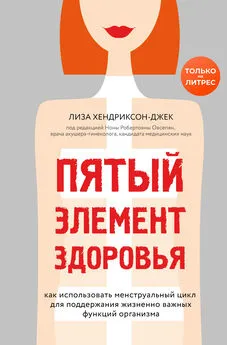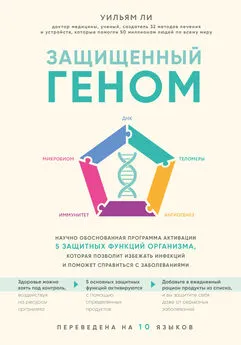Лиза Хендриксон-Джек - Пятый элемент здоровья. Как использовать менструальный цикл для поддержания жизненно важных функций организма
- Название:Пятый элемент здоровья. Как использовать менструальный цикл для поддержания жизненно важных функций организма
- Автор:
- Жанр:
- Издательство:Литагент 5 редакция
- Год:2020
- Город:Москва
- ISBN:978-5-04-104425-1
- Рейтинг:
- Избранное:Добавить в избранное
-
Отзывы:
-
Ваша оценка:
Лиза Хендриксон-Джек - Пятый элемент здоровья. Как использовать менструальный цикл для поддержания жизненно важных функций организма краткое содержание
«Почти» – потому что у женщин есть пятый показатель здоровья, на который, к сожалению, все еще мало кто обращает внимание, – это менструальный цикл. Короткий или длинный, регулярный или непредсказуемый – цикл может быть очень разным, и каждый его параметр, каждое изменение служат индикатором той или иной проблемы в организме. Планируете вы беременность или нет, овуляция имеет значение для поддержания здоровья.
Автор этой книги расскажет, что именно влияет на состояние менструального цикла, и научит вас составлять его график для максимально точного и удобного отслеживания различных изменений и контроля здоровья.
Пятый элемент здоровья. Как использовать менструальный цикл для поддержания жизненно важных функций организма - читать онлайн бесплатно ознакомительный отрывок
Интервал:
Закладка:
57. Там же, 1239.
58. Behre, Hermann M., Michael Zitzmann, Richard A. Anderson, David J. Handelsman, Silvia W. Lestari, Robert I. McLachlan, M. Cristina Meriggiola et al. “Efficacy and safety of an injectable combination hormonal Contraceptive for men.” The Journal of Clinical Endocrinology & Metabolism 101, no. 12 (2016): 4779–4788.
59. Там же, 4782.
60. Там же, 4781.
61. Там же, 4784.
62. Там же, 4783.
63. Там же, 4781.
64. Там же, 4781.
65. Havlicek, Jan, S. Craig Roberts, and Jaroslav Flegr. “Women’s preference for dominant male odour: effects of menstrual cycle and relationship status.” Biology Letters 1, no. 3 (2005): 256–259; Havlicek, Jan, and S. Craig Roberts. “MHC-correlated mate choice in humans: a review.” Psychoneuroendocrinology 34, no. 4 (2009): 497–512; Wedekind, Claus, and Sandra Füri. “Body odour preferences in men and women: do they aim for specific MHC combinations or simply heterozygosity?” Proceedings of the Royal Society of London B: Biological Sciences 264, no. 1387 (1997): 1473–1478; Thornhill, Randy, Steven W. Gangestad, Robert Miller, Glenn Scheyd, Julie K. McCollough, and Melissa Franklin. “Major histocompatibility complex genes, symmetry, and body scent attractiveness in men and women.” Behavioral Ecology 14, no. 5 (2003): 668–678; Little, Anthony C., Benedict C. Jones, and Robert P. Burriss. “Preferences for masculinity in male bodies change across the menstrual cycle.” Hormones and Behavior 51, no. 5 (2007): 633–639.
66. Havlicek, Jan, and S. Craig Roberts. “MHC-correlated mate choice in humans: a review.” Psychoneuroendocrinology 34, no. 4 (2009): 498; Wedekind, Claus, and Sandra Füri. “Body odour preferences in men and women: do they aim for specific MHC combinations or simply heterozygosity?” Proceedings of the Royal Society of London B: Biological Sciences 264, no. 1387 (1997): 1471; Penn, Dustin J. “The scent of genetic compatibility: sexual selection and the major histocompatibility complex.” Ethology 108, no. 1 (2002): 1–21.
67. Thornhill, Randy, Steven W. Gangestad, Robert Miller, Glenn Scheyd, Julie K. McCollough, and Melissa Franklin. “Major histocompatibility complex genes, symmetry, and body scent attractiveness in men and women.” Behavioral Ecology 14, no. 5 (2003): 668–678.
68. Havlicek, Jan, S. Craig Roberts, and Jaroslav Flegr. “Women’s preference for dominant male odour: effects of menstrual cycle and relationship status.” Biology Letters 1, no. 3 (2005): 256–257; Wedekind, Claus, and Sandra Füri. “Body odour preferences in men and women: do they aim for specific MHC combinations or simply heterozygosity?” Proceedings of the Royal Society of London B: Biological Sciences 264, no. 1387 (1997): 1476–1477; Alvergne, Alexandra, and Virpi Lummaa. “Does the contraceptive pill alter mate choice in humans?” Trends in Ecology & Evolution 25, no. 3 (2010): 171–179; Roberts, S. Craig, Anthony C. Little, L. Morris Gosling, David I. Perrett, Vaughan Carter, Benedict C. Jones, Ian Penton-Voak, and Marion Petrie. “MHC-heterozygosity and human facial attractiveness.” Evolution and Human Behavior 26, no. 3 (2005): 213–226; Penn, Dustin J. “The scent of genetic compatibility: sexual selection and the major histocompatibility complex.” Ethology 108, no. 1 (2002): 5–8; Ober, Carole, Lowell R. Weitkamp, Nancy Cox, Harvey Dytch, Donna Kostyu, and Sherman Elias. “HLA and mate choice in humans.” The American Journal of Human Genetics 61, no. 3 (1997): 497–504.
69. Little, Anthony C., Benedict C. Jones, and Robert P. Burriss. “Preferences for masculinity in male bodies change across the menstrual cycle.” Hormones and Behavior 51, no. 5 (2007): 637; O’Connor, Jillian J.M., David R. Feinberg, Paul J. Fraccaro, Diana J. Borak, Cara C. Tigue, Daniel E. Re, Benedict C. Jones, Anthony C. Little, and Bernard Tiddeman. “Female preferences for male vocal and facial masculinity in videos.” Ethology 118, no. 4 (2012): 321–330; Little, Anthony C., Benedict C. Jones, D. Michael Burt, and David I. Perrett. “Preferences for symmetry in faces change across the menstrual cycle.” Biological Psychology 76, no. 3 (2007): 209–216; Debruine, L.M., B.C. Jones, D.A. Frederick, M.G. Haselton, I.S. Penton-Voak, and D.I. Perrett. “Evidence for menstrual cycle shifts in women’s preferences for masculinity: a response to Harris (in press) ‘menstrual cycle and facial preferences reconsidered.’” Evolutionary Psychology 8, no. 4 (2010): 768–775; Little, Anthony C., Robert P. Burriss, Marion Petrie, Benedict C. Jones, and S. Craig Roberts. “Oral contraceptive use in women changes preferences for male facial masculinity and is associated with partner facial masculinity.” Psychoneuroendocrinology 38, no. 9 (2013): 1777–1785; Peterson, Ashley, Rachael Carmen, and Glenn Geher. “Ovulatory shifts in mating intelligence.” Journal of Social, Evolutionary, and Cultural Psychology 7, no. 1 (2013): 66.
70. Ober, C., S. Elias, D.D. Kostyu, and W.W. Hauck. “Decreased fecundability in Hutterite couples sharing HLA-DR.” American Journal of Human Genetics 50, no. 1 (1992): 9–13.
71. Ober, Carole, Terry Hyslop, Sherman Elias, Lowell R. Weitkamp, and Walter W. Hauck. “Human leukocyte antigen matching and fetal loss: results of a 10 year prospective study.” Human Reproduction 13, no. 1 (1998): 35–37; Beydoun, H., and A.F. Saftlas. “Association of human leucocyte antigen sharing with recurrent spontaneous abortions.” Tissue Antigens 65, no. 2 (2005): 123–35.
72. Alvergne, Alexandra, and Virpi Lummaa. “Does the contraceptive pill alter mate choice in humans?” Trends in Ecology & Evolution 25, no. 3 (2010): 2–4; Kuukasjärvi, Seppo, C.J. Peter Eriksson, Esa Koskela, Tapio Mappes, Kari Nissinen, and Markus J. Rantala. “Attractiveness of women’s body odors over the menstrual cycle: the role of oral contraceptives and receiver sex.” Behavioral Ecology 15, no. 4 (2004): 579–584; Puts, David A., Drew H. Bailey, Rodrigo A. Cárdenas, Robert P. Burriss, Lisa L.M. Welling, John R. Wheatley, and Khytam Dawood. “Women’s attractiveness changes with estradiol and progesterone across the ovulatory cycle.” Hormones and Behavior 63, no. 1 (2013): 13–19.
73. Rosvall, Kimberly A. “Intrasexual competition in females: evidence for sexual selection?” Behavioral Ecology (2011): arr106; Cobey, Kelly D., Christine Klipping, and Abraham P. Buunk. “Hormonal contraceptive use lowers female intrasexual competition in pair-bonded women.” Evolution and Human Behavior 34, no. 4 (2013): 294–298.
74. Miller, Geoffrey, Joshua M. Tybur, and Brent D. Jordan. “Ovulatory cycle effects on tip earnings by lap dancers: economic evidence for human estrus?” Evolution and Human Behavior 28, no. 6 (2007): 375–381.
75. Webb, J.L. “Nutritional effects of oral contraceptive use: a review.” The Journal of Reproductive Medicine 25, no. 4 (1980): 150–156; Shojania, A. Majid. “Oral contraceptives: effect of folate and vitamin B 12metabolism.” Canadian Medical Association Journal 126, no. 3 (1982): 244; Li, X., J. Ran, and H. Rao. “Megaloblastic changes in cervical epithelium associated with oral contraceptives and changes after treatment with folic acid.” Chinese Journal of Obstetrics and Gynecology 30, no. 7 (1995): 410–413; Albright, F., A.M. Butler, A.O. Hampton, P. Smith, M.B. Dockerty, R.K. Ghormley, R.L.J. Kennedy, and D.G. Pugh. “The pill and folate metabolism.” The BMJ (1971); Shere, Mahvash, Priya Bapat, Cheri Nickel, Bhushan Kapur, and Gideon Koren. “Association between use of oral contraceptives and folate status: a systematic review and meta-analysis.” Journal of Obstetrics and Gynaecology Canada 37, no. 5 (2015): 430–438; Bielenberg, J. “Folic acid and vitamin deficiency caused by oral contraceptives.” Medizinische Monatsschrift fur Pharmazeuten 14, no. 8 (1991): 244–247.
76. Shere, Mahvash, Priya Bapat, Cheri Nickel, Bhushan Kapur, and Gideon Koren. “Association between use of oral contraceptives and folate status: a systematic review and meta-analysis.” Journal of Obstetrics and Gynaecology Canada 37, no. 5 (2015): 430–438.
77. Там же.
78. Green, Timothy J., Lisa A. Houghton, Ursula Donovan, Rosalind S. Gibson, and Deborah L. O’Connor. “Oral contraceptives did not affect biochemical folate indexes and homocysteine concentrations in adolescent females.” Journal of the American Dietetic Association 98, no. 1 (1998): 49–55; McWilson, Stephanie, Brittney N. Bivins, Katelyn A. Russell, and Lynn B. Bailey. “Oral contraceptive use: impact on folate, vitamin B 6, and vitamin B 12status.” Nutrition Reviews 69, no. 10 (2011): 572–583; McArthur, Jennifer O., HoMan Tang, Peter Petocz, and Samir Samman. “Biological variability and Impact of oral contraceptives on vitamins B 6, B 12and folate status in women of reproductive age.” Nutrients 5, no. 9 (2013): 3634–3645; Sütterlin, Marc W., Stefanie S. Bussen, Lorenz Rieger, Johannes Dietl, and Thomas Steck. “Serum folate and Vitamin B 12levels in women using modern oral contraceptives (OC) containing 20 μg ethinyl estradiol.” European Journal of Obstetrics & Gynecology and Reproductive Biology 107, no. 1 (2003): 57–61; Mountifield, J.A. “Serum vitamin B 12and folate levels in women taking oral contraceptives.” Canadian Family Physician 32 (1986): 862–865.
79. Mountifield, J.A. “Serum vitamin B12 and folate levels in women taking oral contraceptives.” Canadian Family Physician 32 (1986): 863; McArthur, Jennifer O., HoMan Tang, Peter Petocz, and Samir Samman. “Biological variability and Impact of oral contraceptives on vitamins B 6, B 12and folate status in women of reproductive age.” Nutrients 5, no. 9 (2013): 3639–3643; Palmery, M., A. Saraceno, A. Vaiarelli, and G. Carlomagno. “Oral contraceptives and changes in nutritional requirements.” European Review for Medical and Pharmacological Sciences 17, no. 13 (2013): 1804–1813.
80. McArthur, Jennifer O., HoMan Tang, Peter Petocz, and Samir Samman. “Biological variability and Impact of oral contraceptives on vitamins B 6, B 12and folate status in women of reproductive age.” Nutrients 5, no. 9 (2013): 3634–3645; Sütterlin, Marc W., Stefanie S. Bussen, Lorenz Rieger, Johannes Dietl, and Thomas Steck. “Serum folate and Vitamin B 12levels in women using modern oral contraceptives (OC) containing 20 μg ethinyl estradiol.” European Journal of Obstetrics & Gynecology and Reproductive Biology 107, no. 1 (2003): 57–61; Green, Timothy J., Lisa A. Houghton, Ursula Donovan, Rosalind S. Gibson, and Deborah L. O’Connor. “Oral contraceptives did not affect biochemical folate indexes and homocysteine concentrations in adolescent females.” Journal of the American Dietetic Association 98, no. 1 (1998): 49–55.
81. Lassi, Zohra S., and Zulfiqar A. Bhutta. “Clinical utility of folate-containing oral contraceptives.” International Journal of Women’s Health 4 (2012): 185–190; Taylor, Thomas N., Raymond A. Farkouh, Jonathan B. Graham, Antje Colligs, Marion Lindemann, Richard Lynen, and Sean D. Candrilli. “Potential reduction in neural tube defects associated with use of Metafolin-fortified oral contraceptives in the United States.” American Journal of Obstetrics and Gynecology 205, no. 5 (2011): 460-e1; Holzgreve, Wolfgang, Klaus Pietrzik, Berthold Koletzko, and Christel Eckmann-Scholz. “Adding folate to the contraceptive pill: a new concept for the prevention of neural tube defects.” The Journal of Maternal-Fetal & Neonatal Medicine 25, no. 9 (2012): 1529–1536; Wiesinger, Herbert, Urte Eydeler, Frank Richard, Dietmar Trummer, Hartmut Blode, Beate Rohde, and Konstanze Diefenbach. “Bioequivalence evaluation of a folate-supplemented oral contraceptive containing ethinylestradiol/drospirenone/levomefolate calcium versus ethinylestradiol/drospirenone and levomefolate calcium alone.” Clinical Drug Investigation 32, no. 10 (2012): 673–684.
Читать дальшеИнтервал:
Закладка:









